2010.5 Peugeot 508 Dag display
[x] Cancel search: displayPage 107 of 330
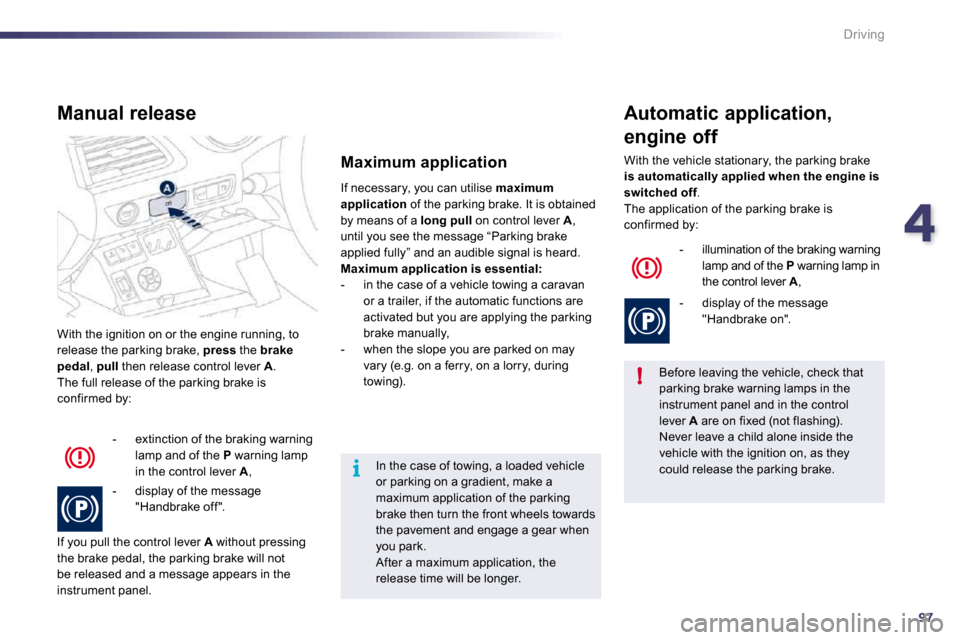
497
!
i
Driving
With the ignition on or the engine running, to release the parking brake, press the brake pedal , pull then release control lever A . The full release of the parking brake is confirmed by:
Manual release
- extinction of the braking warning lamp and of the P warning lamp in the control lever A ,
- display of the message "Handbrake off ".
If you pull the control lever A without pressing the brake pedal, the parking brake will not be released and a message appears in the instrument panel.
If necessary, you can utilise maximum application of the parking brake. It is obtained by means of a long pull on control lever A , until you see the message “Parking brake applied fully” and an audible signal is heard. Maximum application is essential: - in the case of a vehicle towing a caravan or a trailer, if the automatic functions are activated but you are applying the parking brake manually, - when the slope you are parked on may vary (e.g. on a ferry, on a lorry, during towing).
Maximum application
Before leaving the vehicle, check that parking brake warning lamps in the instrument panel and in the control lever A are on fixed (not flashing).
Never leave a child alone inside the vehicle with the ignition on, as they could release the parking brake.
Automatic application,
engine off
- illumination of the braking warning lamp and of the P warning lamp in the control lever A ,
- display of the message "Handbrake on".
With the vehicle stationary, the parking brake is automatically applied when the engine is switched off. The application of the parking brake is confirmed by:
In the case of towing, a loaded vehicle
or parking on a gradient, make a maximum application of the parking brake then turn the front wheels towards the pavement and engage a gear when you park. After a maximum application, the release time will be longer.
Page 108 of 330
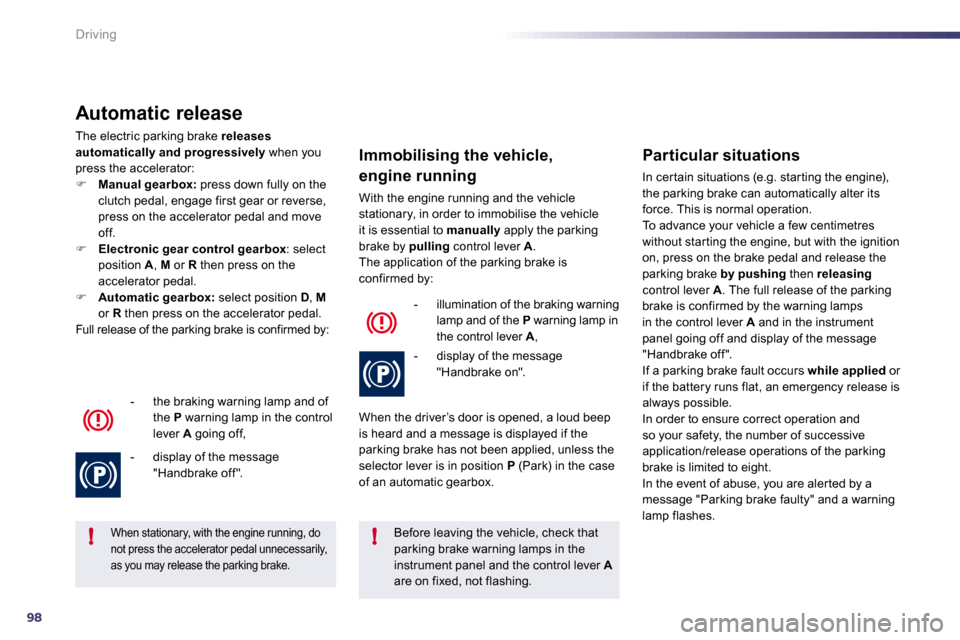
98
!!
Driving
Automatic release
The electric parking brake releases automatically and progressively when you press the accelerator: � Manual gearbox: press down fully on the clutch pedal, engage first gear or reverse, press on the accelerator pedal and move
off. � Electronic gear control gearbox : select position A , M or R then press on the accelerator pedal. � Automatic gearbox: select position D , Mor R then press on the accelerator pedal. Full release of the parking brake is confirmed by:
- the braking warning lamp and of the P warning lamp in the control
lever A going off,
- display of the message "Handbrake off ".
When stationary, with the engine running, do not press the accelerator pedal unnecessarily, as you may release the parking brake.
Before leaving the vehicle, check that parking brake warning lamps in the instrument panel and the control lever Aare on fixed, not flashing.
Immobilising the vehicle,
engine running
With the engine running and the vehicle stationary, in order to immobilise the vehicle it is essential to manually apply the parking brake by pulling control lever A . The application of the parking brake is confirmed by:
- illumination of the braking warning lamp and of the P warning lamp in the control lever A ,
- display of the message "Handbrake on".
When the driver’s door is opened, a loud beep is heard and a message is displayed if the parking brake has not been applied, unless the selector lever is in position P (Park) in the case of an automatic gearbox.
Particular situations
In cer tain situations (e.g. star ting the engine), the parking brake can automatically alter its force. This is normal operation. To advance your vehicle a few centimetres without star ting the engine, but with the ignition on, press on the brake pedal and release the parking brake by pushing then releasingcontrol lever A . The full release of the parking brake is confirmed by the warning lamps in the control lever A and in the instrument panel going off and display of the message "Handbrake off ". If a parking brake fault occurs while applied or if the battery runs flat, an emergency release is always possible. In order to ensure correct operation and
so your safety, the number of successive application/release operations of the parking brake is limited to eight. In the event of abuse, you are aler ted by a message "Parking brake faulty" and a warning lamp flashes.
Page 109 of 330
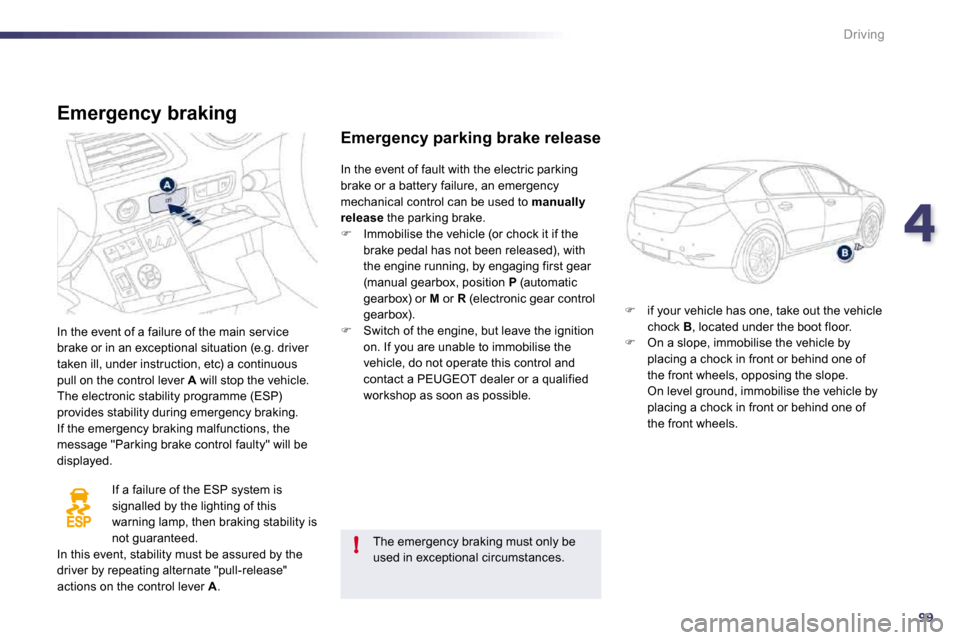
499
!
Driving
Emergency braking
In the event of a failure of the main ser vice brake or in an exceptional situation (e.g. driver taken ill, under instruction, etc) a continuous pull on the control lever A will stop the vehicle. The electronic stability programme (ESP) provides stability during emergency braking. If the emergency braking malfunctions, the message "Parking brake control faulty" will be displayed.
If a failure of the ESP system is signalled by the lighting of this warning lamp, then braking stability is
not guaranteed. In this event, stability must be assured by the driver by repeating alternate "pull-release" actions on the control lever A .
Emergency parking brake release
� if your vehicle has one, take out the vehicle chock B , located under the boot floor. � On a slope, immobilise the vehicle by placing a chock in front or behind one of the front wheels, opposing the slope. On level ground, immobilise the vehicle by placing a chock in front or behind one of the front wheels.
In the event of fault with the electric parking brake or a battery failure, an emergency mechanical control can be used to manually release the parking brake. � Immobilise the vehicle (or chock it if the brake pedal has not been released), with the engine running, by engaging first gear (manual gearbox, position P (automatic gearbox) or M or R (electronic gear control gearbox). � Switch of the engine, but leave the ignition on. If you are unable to immobilise the vehicle, do not operate this control and contact a PEUGEOT dealer or a qualified workshop as soon as possible.
The emergency braking must only be used in exceptional circumstances.
Page 111 of 330
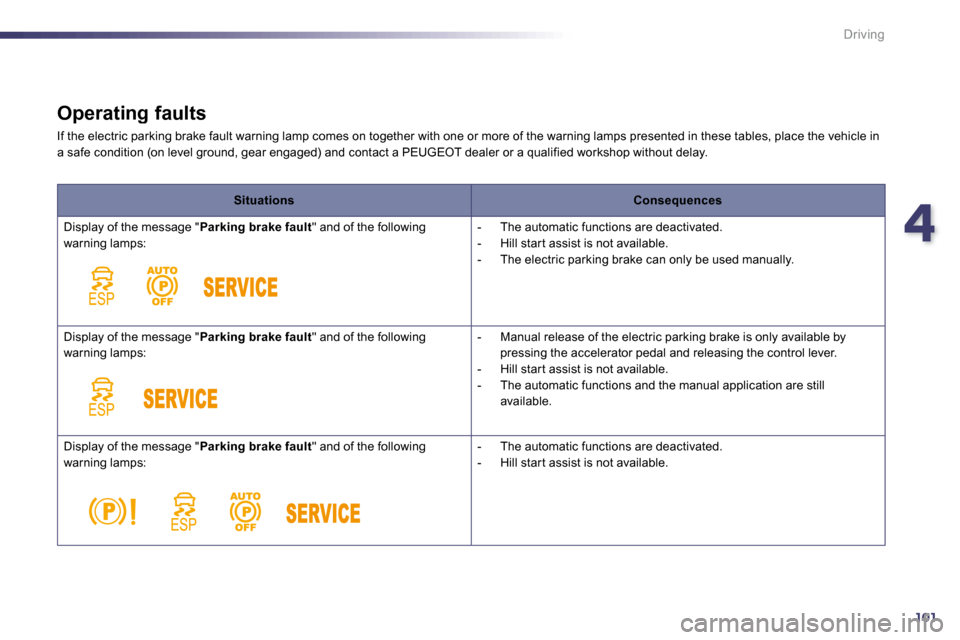
4101
Driving
Operating faults
If the electric parking brake fault warning lamp co mes on together with one or more of the warning lamps p resented in these tables, place the vehicle in a safe condition (on level ground, gear engaged) and contact a PEUGEOT dealer or a qualified workshop with out delay.
SituationsConsequences
Display of the message " Parking brake fault " and of the following warning lamps: - The automatic functions are deactivated. - Hill star t assist is not available. - The electric parking brake can only be used manually.
Display of the message " Parking brake fault " and of the following warning lamps: - Manual release of the electric parking brake is only available by pressing the accelerator pedal and releasing the con trol lever. - Hill star t assist is not available. - The automatic functions and the manual applicatio n are still available.
Display of the message " Parking brake fault " and of the following warning lamps: - The automatic functions are deactivated. - Hill star t assist is not available.
Page 112 of 330
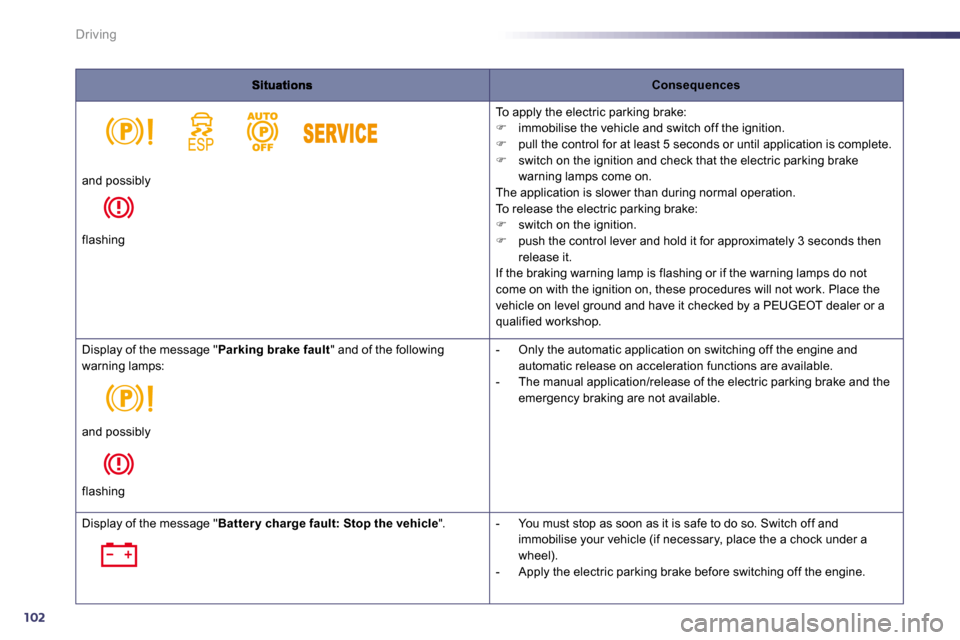
102
Driving
Consequences
To apply the electric parking brake: � immobilise the vehicle and switch off the ignition. � pull the control for at least 5 seconds or until app lication is complete. � switch on the ignition and check that the electric parking brake warning lamps come on. The application is slower than during normal operati on. To release the electric parking brake:
� switch on the ignition. � push the control lever and hold it for approximately 3 seconds then release it. If the braking warning lamp is flashing or if the warning lamps do not come on with the ignition on, these procedures will not work. Place the vehicle on level ground and have it checked by a PEU GEOT dealer or a qualified workshop.
and possibly
flashing
Display of the message " Parking brake fault " and of the following warning lamps: - Only the automatic application on switching off the engine and automatic release on acceleration functions are avail able. - The manual application/release of the electric parking brake and the emergency braking are not available.
and possibly
flashing
Display of the message " Batter y charge fault: Stop the vehicle ". - You must stop as soon as it is safe to do so. Swi tch off and
immobilise your vehicle (if necessary, place the a chock under a wheel). - Apply the electric parking brake before switching off the engine.
Page 113 of 330

499
!
Driving
Emergency braking
In the event of a failure of the main ser vice brake or in an exceptional situation (e.g. driver taken ill, under instruction, etc) a continuous pull on the control lever A will stop the vehicle. The electronic stability programme (ESP) provides stability during emergency braking. If the emergency braking malfunctions, the message "Parking brake control faulty" will be displayed.
If a failure of the ESP system is signalled by the lighting of this warning lamp, then braking stability is
not guaranteed. In this event, stability must be assured by the driver by repeating alternate "pull-release" actions on the control lever A .
Emergency parking brake release
� if your vehicle has one, take out the vehicle chock B , located under the boot floor. � On a slope, immobilise the vehicle by placing a chock in front or behind one of the front wheels, opposing the slope. On level ground, immobilise the vehicle by placing a chock in front or behind one of the front wheels.
In the event of fault with the electric parking brake or a battery failure, an emergency mechanical control can be used to manually release the parking brake. � Immobilise the vehicle (or chock it if the brake pedal has not been released), with the engine running, by engaging first gear (manual gearbox, position P (automatic gearbox) or M or R (electronic gear control gearbox). � Switch of the engine, but leave the ignition on. If you are unable to immobilise the vehicle, do not operate this control and contact a PEUGEOT dealer or a qualified workshop as soon as possible.
The emergency braking must only be used in exceptional circumstances.
Page 119 of 330
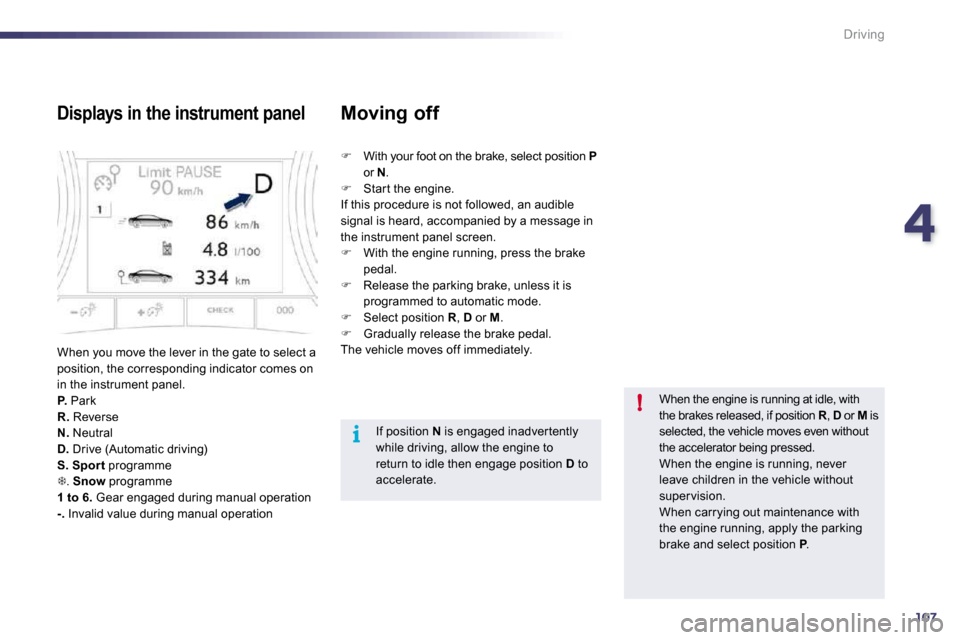
4107
i
!
Driving
Displays in the instrument panel
When you move the lever in the gate to select a position, the corresponding indicator comes on in the instrument panel. P. Park R. Reverse N. Neutral D. Drive (Automatic driving) S. Spor t programme � . Snow programme 1 to 6. Gear engaged during manual operation -. Invalid value during manual operation
� With your foot on the brake, select position P or N . � Star t the engine. If this procedure is not followed, an audible signal is heard, accompanied by a message in the instrument panel screen. � With the engine running, press the brake pedal. � Release the parking brake, unless it is programmed to automatic mode. � Select position R , D or M . � Gradually release the brake pedal. The vehicle moves off immediately.
Moving off
When the engine is running at idle, with the brakes released, if position R , R D or M is selected, the vehicle moves even without the accelerator being pressed. When the engine is running, never leave children in the vehicle without super vision. When carrying out maintenance with the engine running, apply the parking brake and select position P . PP
If position N is engaged inadver tently while driving, allow the engine to return to idle then engage position D to accelerate.
Page 121 of 330
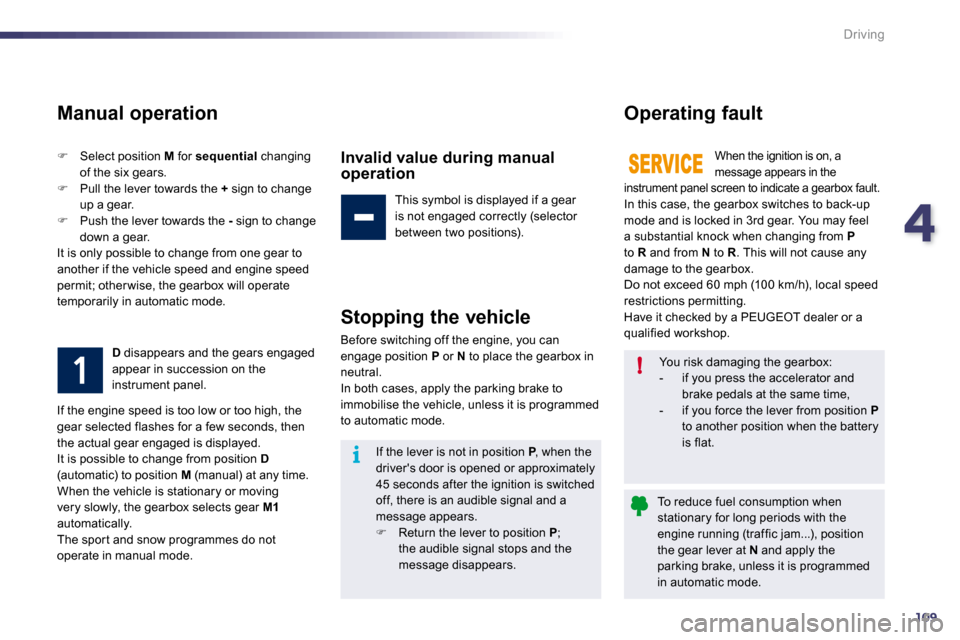
4109
i
!
Driving
Manual operation
� Select position M for sequential changing of the six gears. � Pull the lever towards the + sign to change up a gear. � Push the lever towards the - sign to change down a gear. It is only possible to change from one gear to another if the vehicle speed and engine speed permit; other wise, the gearbox will operate temporarily in automatic mode.
D disappears and the gears engaged appear in succession on the instrument panel.
Invalid value during manual operation
This symbol is displayed if a gear is not engaged correctly (selector between two positions).
Stopping the vehicle
Before switching off the engine, you can engage position P or N to place the gearbox in neutral. In both cases, apply the parking brake to immobilise the vehicle, unless it is programmed to automatic mode.
Operating fault
When the ignition is on, a message appears in the instrument panel screen to indicate a gearbox fault . In this case, the gearbox switches to back-up mode and is locked in 3rd gear. You may feel a substantial knock when changing from Pto R and from N to R . This will not cause any damage to the gearbox. Do not exceed 60 mph (100 km/h), local speed restrictions permitting. Have it checked by a PEUGEOT dealer or a qualified workshop.
If the engine speed is too low or too high, the gear selected flashes for a few seconds, then the actual gear engaged is displayed. It is possible to change from position D
(automatic) to position M (manual) at any time. When the vehicle is stationary or moving very slowly, the gearbox selects gear M1automatically. The spor t and snow programmes do not operate in manual mode.
You risk damaging the gearbox: - if you press the accelerator and brake pedals at the same time, - if you force the lever from position Pto another position when the battery
is flat. If the lever is not in position P , when the Pdriver's door is opened or approximately
45 seconds after the ignition is switched off, there is an audible signal and a message appears. � Return the lever to position P ; the audible signal stops and the message disappears.
To reduce fuel consumption when stationary for long periods with the engine running (traffic jam...), position the gear lever at N and apply the parking brake, unless it is programmed in automatic mode.